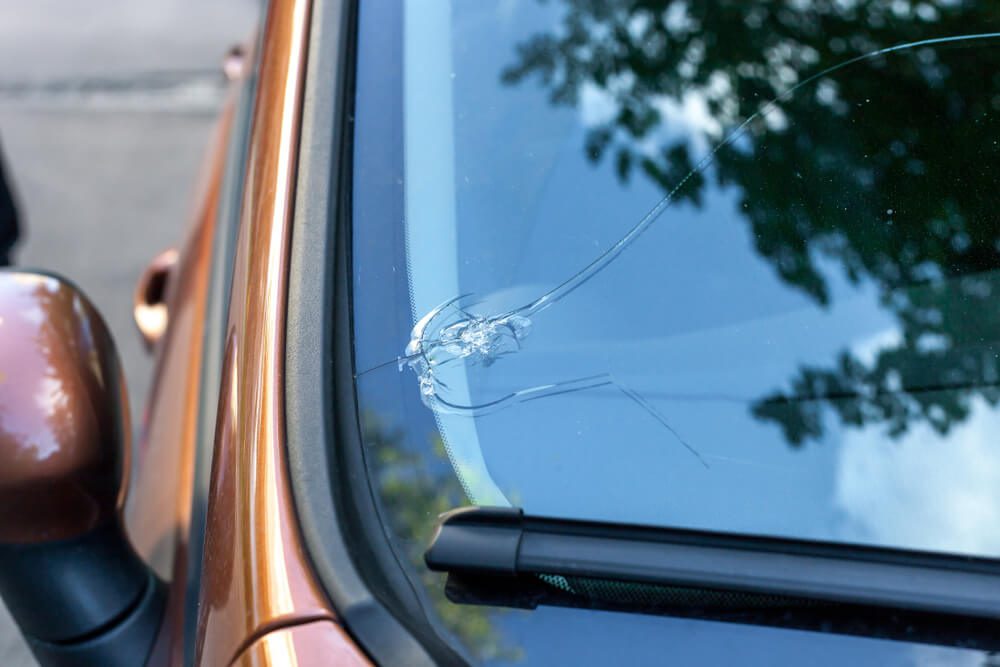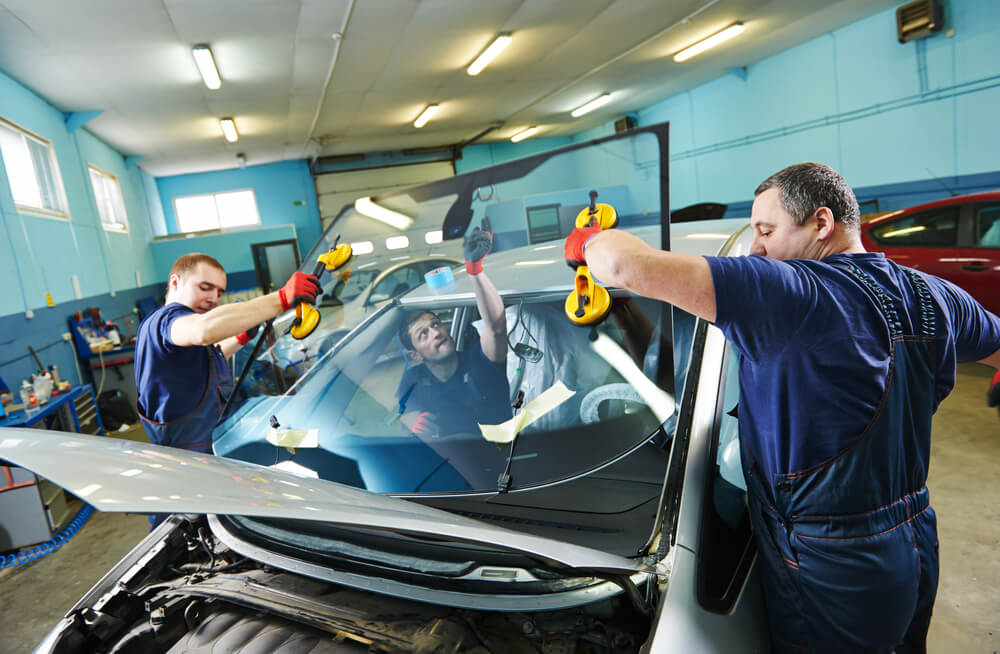What should I do if my car has a chipped windscreen

Your windscreen is a critical component of your car that often goes unnoticed. It provides you with a clear view of the road, your surroundings, protects you from wind and rain, and also acts as a safety barrier in the event of an accident.
Windscreens are made up of a strong and durable sheet of laminated glass. Laminated glass is known for how difficult it is to break into and damage, making it the perfect choice for your windscreen.
But every now and then, it can sustain a little chip or crack. It’s often unavoidable and through no fault of your own. However, you’ll still need to get it repaired as a damaged windscreen can have a dire impact on you and your car’s safety.
Therefore, in this article, we’ll explore all things related to a chipped windscreen, such as what to do when it occurs, what causes it, how you can prevent it from happening, and much more.
What should I do if my car has a chipped windscreen?
The best thing you can do is to get it repaired immediately. Whilst a small chip can seem negligible, it will slowly grow, eventually resulting in a larger chip which can cause the entire windscreen to crack. The costs to replace your windscreen can be high, so it’s best to treat the damage immediately whilst it is still tiny.
Most car repair garages will be able to fix the chip on the spot or, at the very least, prevent it from spreading throughout the windscreen. This will buy you some time to find a more permanent fix without the risk of making matters worse.
What causes a cracked or chipped windscreen?
There are numerous causes for a cracked or chipped windscreen. Usually, it is due to small debris which is kicked up from the road that hits the car’s windscreen at high speed, such as small rocks, pebbles, and gravel. Whilst this isn’t your fault, it can be extremely inconvenient as it will require immediate repair if you want to prevent it from spreading.
Rapid temperature changes can also cause chips and cracks. For instance, if your car windscreen has iced over during winter and you put boiling water on it, this sudden change in temperature can cause it to crack as the individual glass particles rapidly expand.
However, sometimes there won’t be an obvious cause. A tiny unnoticeable chip can be on your windscreen for months before it suddenly grows to a visible size. Hence why it’s good practice to routinely inspect your windscreen for any small chips or scratches that could become worse.
Small Chip on Windscreen
How serious is a chipped windscreen?
A damaged windscreen can be a serious problem if it isn’t addressed straight away. Even a tiny chip can quickly develop into a crack and potentially even shatter the whole windscreen.
A chip or crack can also drastically reduce the structural integrity of the vehicle’s windscreen and the car itself. For instance, in the event of an accident, a chip can cause the driver and passenger airbag to inflate the wrong way. Or, in the event of a more severe crash where the vehicle rolls over, the roof will be more likely to cave in. This could put the lives of you and your passengers at severe risk.
One of, if not the most, essential safety precautions when driving is maintaining a clear line of sight. Drivers need to be able to see everything in front of them to react in time. Chipped windscreens can affect a driver’s vision, making it hard to see approaching traffic or a hazard – a second’s delay can be the difference between avoiding an accident and not.
Even something as small as a scratch can be a problem. If sunlight or a car headlight hits that spot at the right angle, it could cause glare and dazzle you. That’s why a driver’s line of sight is crucial and chipped or cracked windscreens can put drivers and their passengers in danger.
How do I prevent my windscreen from getting chipped or cracked?
Whilst there is nothing you can do about unlucky situations, there are precautions you can take to minimise the risk of chipping and cracking.
It’s a good idea to inspect your windscreen for scratches, chips, and other damages every few months. This will allow you to stay ahead and catch any problems before they occur.
It’s also recommended to clean or replace your windscreen wipers once a year to ensure that they are still working correctly. Often, dirt and debris can build up on the wipers, which can chip the windscreen as it glides across it.
Sudden changes in temperature can crack glass. Therefore, during the winter months, when your windscreen freezes over with ice, you must avoid pouring hot or boiling water onto it. Instead, you can use the old-fashioned method of sweeping it off using a scraper or use a de-icing spray to clear it up.
The last precautionary measure involves your driving habits. Driving carefully on damaged, newly laid, or resurfaced roads will help you avoid stones and gravel that are kicked up. On the same token, keeping a reasonable but sensible distance between you and the car in front will help reduce this risk further.
How do I prevent a chip in my windscreen from spreading?
If you spot a chip in your windscreen, even if it is small, don’t be tempted to ignore it. Over time it will slowly develop into a crack which is far worse for the car and your safety, and it can spread across your whole windscreen. A fully cracked windscreen means the entire thing will have to be completely replaced, so it’s better to nip it in the bud early.
Speed and efficiency are critical when it comes to windscreen chip repair, but that’s not always possible. You may not be able to get to a car repair garage to get it fixed promptly. In such an event, there may be a period of time when you have to drive with a cracked or chipped windscreen.
This presents its own challenges since that’s more time for the windscreen damage to worsen. Fortunately, you can do something to prevent or slow down the chip from spreading.
You can try to seal it by injecting an epoxy or acrylic adhesive into it. The sealant prevents dirt and moisture from getting inside, which can worsen the chip. Whilst this will work on small chips and cracks, it will be difficult to contain large chips and cracks with this method.
Additionally, you should try to avoid sudden temperature changes. It’s also a good idea to avoid large potholes on the road since the impact can worsen the damage.
Is it illegal to have a chipped windscreen?
Depending on how severe the damage is, driving with a chipped or cracked windscreen can be a motoring offence.
The Highway Code outlines that all glass on your vehicle, including the front and back windscreen and side windows, must be in good and roadworthy condition. This means that your view of the road should not be impeded in any way, and the glass should be kept clean.
Suppose the police stop you, and they deem your windscreen to be severely damaged. In that case, you can receive up to three penalty points on your driving licence in addition to a £2,500 fine.
In the event that you have a chipped windscreen and are in an accident, you may be charged with a more serious driving offence. Also, you could be found responsible for the accident since you were driving with a damaged windscreen.
Can a chipped windscreen fail an MOT test?
As part of your MOT test, the condition of your windscreen will be assessed. If it is found to be chipped or cracked, it can result in your failing the test. However, it’s not so black and white. The exact details of the damage, where it is, and how big it is will be considered.
Windscreen cracks or chips that are 40mm in size will result in MOT failure, regardless of where exactly it is. You will have to get the windscreen repaired before the car can be re-tested.
Cracks or chips that are 10mm in size and in the driver’s line of sight will also result in an MOT failure. This is because the damage falls under Zone A of the windscreen. Zone A is a 290mm wide section that starts directly in front of the steering wheel up to where the windscreen wipers reach. This zonal area is considered within the driver’s direct line of vision, hence the more stringent measures.
Once the damage has been repaired, it can be re-tested. It’s only after passing the MOT re-test that your car will be deemed as in roadworthy condition.
Does my car insurance cover windscreen repairs?
If you have taken out a comprehensive insurance policy, windscreen cover should be included as standard. However, some insurance providers don’t cover windscreen repairs, so it’s best to check your insurance policy.
With windscreen cover, although you won’t have to pay for the costs of windscreen replacements and repairs, it may affect your no-claims bonus, and you may still need to pay the total excess amount. Again, this will depend on your specific policy. If you aren’t covered, most insurers will provide you with the option of including windscreen cover as an add-on.

How much does windscreen repair cost?
Repairing a small chip can cost as little as £40 and will only take around 30 minutes. Cracks will cost a bit more and takes longer, but a complete windscreen replacement can cost up to £400. That’s why it’s important to get small chips and cracks fixed immediately before it snowballs into a bigger problem.
What if I have a chip on my side windows?
Your front windscreen is made from durable and robust laminated glass, but the rear windscreen and side windows are made from tempered glass. Tempered glassworks in the opposite way to laminated glass in that it is designed to fracture into small pieces upon impact. Therefore, a chip or crack in your side window will result in you having to replace the entire thing.
Final thoughts
A car’s windscreen plays a vital role in keeping the driver safe from the elements outside and impacts in the event of an accident. Chips and cracks, regardless of how small they are, can risk the driver’s and passengers’ safety.
Over time, small chips will grow into big ones, which can then develop into cracks. A cracked windscreen is much harder to fix than a chip and is also much more expensive. That’s why it’s vital to get small chips repaired straight away before they present more significant problems for you down the road.



